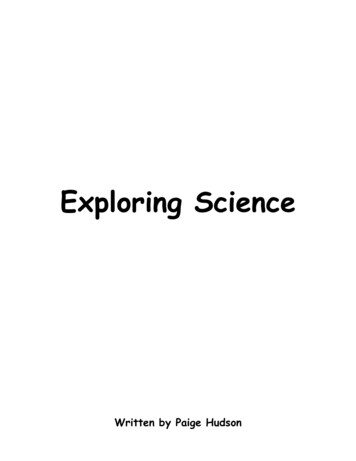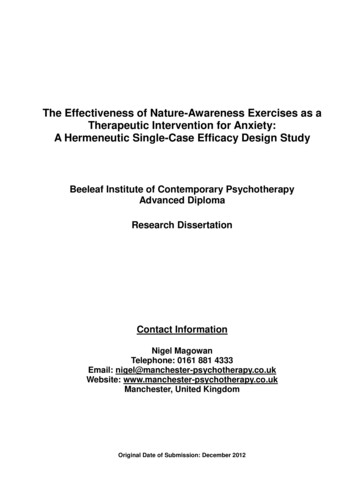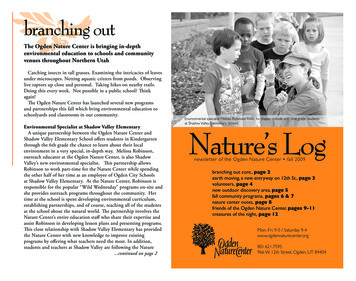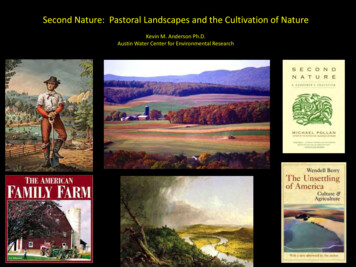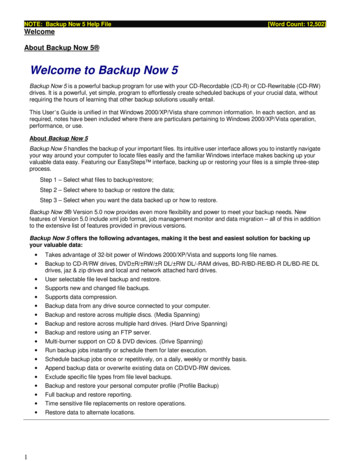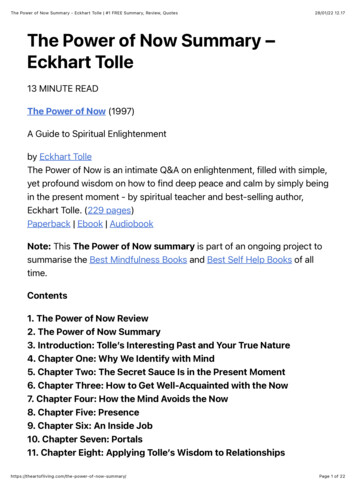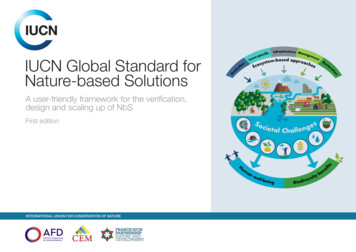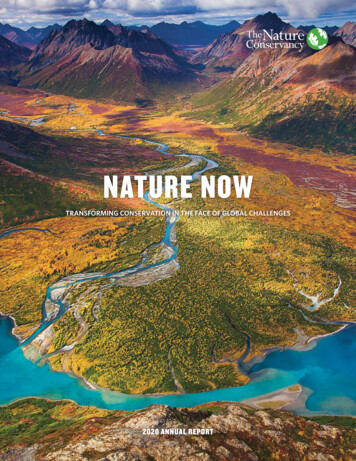
Transcription
NATURE NOWTRANSFORMING CONSERVATION IN THE FACE OF GLOBAL CHALLENGES2020 ANNUAL REPORT
FROM THE CEOTo Build a Futurefor Nature Now“This past year we learned,with more clarity thanever before, just howinterconnected our healthand well-being are to thehealth of the planet.”IN MAY 2020, I joined The Nature Conservancy as chiefexecutive officer—one of the proudest and most joyous daysin my 25-year career in conservation. Of course, the first fewweeks did not go as I expected. Or the first few months. Thedeadly COVID-19 pandemic surged, wreaking havoc on families, health care systems and economies around the world.Nearly a year later, many of us continue to work from homeand maintain physical distance from friends, colleagues andloved ones.While it was a challenging first chapter for me at TNC, an organization I had long admired and hoped to work for one day, wewere able to forge connections and make remarkable progress.I “met” thousands of colleagues and hundreds of trusteesand supporters on Zoom instead of in person. My colleaguesand I learned about our partnerships with Indigenouscommunities to use fire to restore healthy forests throughconversations and photos, without ever feeling the heat of acontrolled burn. We celebrated the creation of Colorado’s new20,000-acre Fishers Peak State Park without looking up at thetowering mountains. And we learned how to plant cacao treesvia a social messaging app alongside planters in Brazil withoutholding a seedling in our hands or smelling the damp soil ofthe surrounding rainforest. You can learn more about theseand other TNC projects in the pages to come.Many of the challenges that marked 2020—a globalpandemic, record temperatures, fires and hurricanes, andlong-overdue reckonings with racist systems and calls forequity—are continuing to impact our lives. But 2020 was alsomarked by a spirit of resilience, tenacity and creativity. Theworld came together to tackle problems in new ways, withunprecedented speed and collaboration. Never before has thescientific community rallied so many minds and resourcesso quickly. The development of powerful new vaccines in lessthan a year has raised hopes for quick action on other globalthreats, like the climate emergency.On the cover: An aerial view of Alaska’s Wood-Tikchik State Park, thelargest state park in the United States at nearly 1.6 million acres. The park’swaters drain into Bristol Bay, the largest remaining sockeye salmon fisheryin the world. In 2020 federal regulators temporarily halted plans for agiant mine in the bay’s headwaters, thanks to efforts by Indigenous groups,fishing communities, conservationists and others. Michael MelfordWarm wishes,Jennifer MorrisChief Executive Officer,The Nature Conservancy ALEX SNYDER/TNC —JENNIFER MORRIS, CHIEF EXECUTIVE OFFICERThis past year we learned, with more clarity than everbefore, just how interconnected our health and well-beingare to the health of our planet. In May 2020, the WorldHealth Organization published its Manifesto for a HealthyRecovery from COVID-19, which recommends protecting andpreserving nature as a top priority. Protecting nature supportseconomies, provides clean air and water and healthy food, andit can also reduce the risk of future zoonotic disease outbreaks, which science tells us are driven in part by habitat lossand climate change.Indeed, the pandemic revealed the power of nature to helpheal—not only through nature-driven solutions like regenerative agriculture, carbon sequestration and clean-energysources like wind and solar but also in helping many peoplemanage life in a world turned upside down. In 2020, visits tonatural areas and parks expanded to record levels, outdoorgear and bicycle sales boomed, backyard birding took offin popularity, and hiking and nature walks surged. Aroundthe world, people rekindled their connections to nature andsought solace in the outdoors.With this optimistic spirit, I reflect on all that The NatureConservancy was able to accomplish with the help of partners,supporters and our volunteer leadership in 2020—and lookahead to a promising decade of nature conservation at a globalscale. I am hopeful we can harness the tenacity and resiliencethat all of us developed in this difficult year to build a betterfuture together.NATURE.ORG/ANNUALREPORT1
THE TRANSFORMATION WE NEEDIN AN ERA OF CHANGE COMES NOW, AT ATIME OF UNPRECEDENTED CHALLENGES.All that we face today calls on us to work for meaningfuland lasting changes that will lead us to a world of newpossibilities for people and nature. For The NatureConservancy, this is the challenge of our time. It’salso the moment for which 70 years of experience andcommitment have prepared us. Now is the time to act;now is the time to transform our world and to protectthe lands and waters on which all life depends.22020 NATURE CONSERVANCY ANNUAL REPORTSEE MOREScan the code with yourphone’s camera to see anupdate on the Caribbean, orvisit nature.org/CoralMapping. PLANET LABS INC.The coral reefs of the Caribbean are a global treasure. Now, for the first timeever, nations have access to high-resolution maps of these underwater habitats,thanks to the dedication of TNC and its science partners. Scientists used imageslike this one from Jardines de la Reina in Cuba, captured via a “constellation” ofmore than 200 satellites, to create maps that can help document damage fromhurricanes, identify restoration priorities and plan future protection.How HUMANITY cares forthe LAND and WATER that sustain usmatters NOW more than ever.NATURE.ORG/ANNUALREPORT3
Rangers at the Randilen Wildlife Management Area inTanzania serve their communities by protecting wildlife.The new 19,200-acre Fishers Peak State Park overlooksTrinidad, Colo., where new recreational opportunities willbring a welcome boon to the local economy.A Global Strategyto Save RiversGOAL Rivers bring life to us all. TNC’snew Durable River Protection frameworkkeeps clean and healthy waters flowing.WHILE THE BALKANS are home to manyof Europe’s last free-flowing rivers, theregion has become a target in recentyears for plans to develop new hydrodams and other water projects. Despitethe threats, TNC efforts in the regionlast year helped protect two rivers: theturquoise blue waters of Montenegro’sZeta River and, to the north, the KrupaRiver in Croatia, which winds throughsteep and rocky canyons.The two governments protected therivers using TNC’s new communityfocused approach to river conservationknown as the Durable River Protectionframework. Modeled on the U.S. Wildand Scenic Rivers Act, the frameworkbrings new policy approaches that cansupport freshwater protections aroundthe world. This is critical because rivershold much of the world’s biodiversitybut are, astonishingly, the least protectedof the Earth’s natural systems.The success in the Balkans will helpsupport adoption of the framework inother countries as well.A New State ParkTransforms a Colorado TownFOR DECADES, RESIDENTS IN the former mining town of Trinidad, Colo., had been watch-42020 NATURE CONSERVANCY ANNUAL REPORTClosing theBiodiversityFinancing GapThe Conservancy’s Alphonce Mallya on the success of TNC’s Africa WildlifeConservancies Crisis Fund, which raised 2.5 million in contributions fromTNC supporters. The emergency fund kept about 950 rangers on patrol inwildlife conservancies in Kenya, Namibia, Tanzania and Zambia—offsettingthe drop in ecotourism-dependent conservation funding due to a 90%decline in visitors. Many were concerned that a crisis could hit both localcommunities and wildlife conservancies, a setback for conservation alliancesthat would leave wildlife at an even greater risk from poaching.THE WORLD’S BIODIVERSITY is under threat. The rate of extinctions is on the rise and climatechange is now exacerbating the threats. Declining biodiversity will have real impacts forpeople, such as threatening clean-water supplies and limiting food sources. For example,threats to pollinators could lead to a costly drop in agricultural output estimated at 217billion annually. A new paper, Financing Nature, published by the Paulson Institute, CornellUniversity and TNC, outlines transformations in policy and finance regulations that wouldunleash new private-sector investments capable of protecting nature and biodiversity. ROSHNI LODHIA 824BAnnual Financing Gap CAMERON DAVIDSONSEE MOREScan the code withyour phone’s camerato see how a new statepark brings vitality toa community, or visitnature.org/FishersPeak.ing young people leave for distant job opportunities. In 2017, Mayor Phil Rico decidedto approach TNC and The Trust for Public Land (TPL) with a plan for change: Wouldthe organizations help protect a neighboring ranch with an eye toward transformingthe city into a thriving hub for outdoor recreation? Last year, that vision came to lifewhen the property was made into a state park crowned by the 9,633-foot Fishers Peak.After TNC and TPL purchased the 19,200-acre ranch with support from GreatOutdoors Colorado, the two groups helped Colorado Parks and Wildlife acquire the 25.4 million property and transform it into Fishers Peak State Park. It promises tobecome an outdoor tourism destination on par with the scenic natural wonders thatalready contribute 62 billion to the state’s economy. The park is home to more than900 species—including elk, bobcat and peregrine falcon—and helps secure a wildlifecorridor from the Sangre de Cristo Mountains to the grasslands of the high plains.“By planning for both ecological and recreational goals from the ground floor,we’ll strive to show how solid conservation outcomes contribute to an economicallythriving community, all while connecting future generations to nature,” says MattMoorhead, TNC’s conservation partnerships advisor in Colorado.“If these rangers had losttheir jobs during the pandemicwe would definitely be losingground on our progress.”Necessary InvestmentExisting Investment0200 143BRead the full report at nature.org/FinancingNature.400600800 967BANNUAL USD (BILLIONS)NATURE.ORG/ANNUALREPORT5
Lined with willows and cottonwood trees, Arizona’sVerde River cuts a lush path through the desert.“A hugelifesaver.”Nature brings FOOD to our tableand WATER to our taps.The PATH AHEAD demands thatwe innovate NOW.Switching to Less Thirsty CropsUses 50% Less Water and InspiresNew OpportunitiesGOAL Farmers need water to feed people and support local economies. TNC is proving thatsmarter crop choices in the arid West can provide more water for both people and nature.Switching to water-savingcrops—like this field of barleyin Arizona—can help providefood and water sustainably.62020 NATURE CONSERVANCY ANNUAL REPORTTHIS PAGE AND OPPOSITE: ANDREW KORNYLAKIN ARIZONA’S VERDE RIVER VALLEY, a commonsense shift on the land has meant bigchanges where it counts: in the life-giving waters of the Verde River. Flowing fromhighlands in central Arizona, the 190-mile-long Verde and its streamside standsof willow and cottonwood are a wellspring of life. The river also irrigates drylandfarms and supplies communities with drinking water. Recently, the river has beenso over-tapped that sections have run dry during summer, threatening the viability of some farmlands and the survival of a rich diversity of wildlife, including twoendangered fish species.To address the problem, TNC, together with local partners in business and farming, proposed a change that seemed capable of doing the impossible: saving preciouswater while growing marketable crops and inspiring the growth of a new sectorin the local economy. In short, TNC worked with the largest farm in the region toswitch to barley, which consumes half the water of thirsty crops like alfalfa and corn.And TNC helped support a new company to process the barley for use in beer.In just three years, the shift to high-quality malting barley has been a big hit withlocal brewers, saved 425 million gallons of water—enough to fill more than 600Olympic-sized swimming pools—and kept the Verde River flowing.This is what Laura Brown, aNew Hampshire oyster farmer,thinks of TNC’s response torestore oyster reefs and support growers hit by decliningsales during the pandemic.The project, led by TNCand The Pew Charitable Trusts,stepped in to create a new market for more than 100 oysterfarmers who found themselvesstruggling when COVID-19shuttered restaurants anddemand for oysters plunged.Shellfish growers in sevenstates can sell their healthysurplus oysters to the project,called SOAR—SupportingOyster Aquaculture and Restoration—which then transplantsthem to nearby reef-restorationsites. A single oyster can filter50 gallons of water in one day,and an entire oyster reef canbe critical to the health of baysand estuaries. Enterprisingoyster farms—both long-heldfamily businesses and recentstart-ups—not only providethese ecological benefitsbut often contribute to ruraleconomies. Fulfilling SOAR’smission of buying 5 millionoysters over a two-year periodmeans producers will be ableto stay afloat while long-termefforts to restore local reefs geta helpful boost.NATURE.ORG/ANNUALREPORT7
Protecting Salmonand Traditions inAlaska’s Bristol BayHarvesting cacao pods to produce chocolate canhelp support reforestation in the Amazon rainforestand provide stable income for small-scale farmers.GOAL Nature bestows a summertimebounty of wild salmon in the crystallinerivers of Alaska’s Bristol Bay. TNC standscommitted to permanently protectingthe bay’s lands and waters from plans toconstruct a mine in the headwaters.A commercial fishing captain and crew bringin a harvest of wild sockeye salmon in Bristol Bay.Timeless traditions live on in Indigenous communities, where the return of the salmon brings peopletogether to harvest fish and preserve it in backyardsmokehouses.SEE MOREScan the code withyour phone’s camerato see how peopleare rallying to savethe waters that havealways sustained them,or visit nature.org/BristolBaySalmon.“Bristol Bay’s timeless wild salmontraditions are alive and well—fornow. But we cannot afford to becomplacent. What we do next, inthis moment, determines thefuture for generations to come.”—STEVE COHN, ALASKA STATE DIRECTOR FOR THE NATURE CONSERVANCY82020 NATURE CONSERVANCY ANNUAL REPORTMobile Phone App Providesa Lifeline for Farmers Helpingto Save the Amazon BRIAN ADAMS (BRISTOL BAY); JOÃO RAMID (AMAZON)IN BRISTOL BAY, the traditional way of lifein Alaska Native villages has always relied on clean water and the yearly returnof wild salmon. These fish number in thetens of millions, more than anywhereelse on the planet, making Bristol Baythe last best hope for a culture andeconomy tied directly to the sustainableharvest of wild salmon. Yet its remarkable rivers, lakes and habitat for bearsand caribou still lack permanent safeguards against threats like the proposedPebble Mine, meaning their future isn’tsafe from harm. TNC’s science has longsupported local Indigenous organizations and the region’s sustainable commercial fishing industry, which, togetherin 2020, helped to temporarily stopthe mine in a sustained campaign thatcontinues today. Through this broad coalition, TNC is building on this win andadvocating for permanent legislativeprotection along with key investmentsin invigorating local economies andIndigenous authority—all transformative steps in building a better future forpeople and nature tied to Bristol Bay.IN THE BRAZILIAN AMAZON, small-scale family farmers have drivenapproximately one-third of the total loss of rainforest by cutting downtrees to create farm fields and cattle pastures for subsistence and income.But since 2012, TNC and the government of the state of Pará have beenproviding technical assistance and training to encourage farmers to growcacao trees—the source of chocolate—to reforest degraded lands andto provide a more sustainable source of income. Last year, however, asharvest time neared, COVID-19 hit Brazil, making it too dangerous toconduct in-person training. The Conservancy turned to a mobile-phonebased social-messaging app to deliver how-to videos to some 250 farmersin time to help with the harvest.NATURE.ORG/ANNUALREPORT9
Smoke rises up during adevastating fire seasonin Australia. Climatechange is contributingto these record fires.Transformative 100 Million GiftBoosts TNC Climate ActionTHE CONSERVANCY’S INNOVATIVE EFFORTS to develop natural climate solutions receiveda tremendous boost from a 100 million gift from the Bezos Earth Fund. The giftfunds climate work in two critical regions—India’s agricultural states of Punjab andHaryana, as well as the Emerald Edge of coastal Washington, British Columbia andAlaska. The funding also supports efforts to replicate natural climate solutions on alarger scale. This gift, the second largest ever received by TNC, jump-starts our pioneering work to harness nature to reduce carbon emissions around the world.CLIMATE CHANGE is the102020 NATURE CONSERVANCY ANNUAL REPORT RALPH A. CLEVENGER/TANDEM STOCK ANDREW MERRY/GETTY IMAGESgreatest challenge of our time.The fix is GLOBAL , it’s LOCAL ,and it starts NOW.INDIAEMERALD EDGEChallenge: Farmers burn crop residueto prepare their fields for new plantings,generating climate emissions and deadlyair pollution in neighboring cities.Challenge: The temperate rainforestsof the Emerald Edge hold one of theworld’s largest stores of carbon, butthese forests are at risk.Solution: Introducing new regenerativeagriculture approaches—including no-tillplanting—ends the need for burning,saves water, increases farmer incomes,boosts soil health and stores carbon.Solution: Preserving coastal rainforestsin partnership with First Nations peoples honors a vision of Indigenous-ledstewardship while securing forests asstorehouses of carbon.“Nature ischanging andwe can’t holdit steady, sowe have tofind a wayto protect itwhile it shifts.”Dr. Mark Anderson, TNC’sdirector of conservationscience for the eastern U.S.,on TNC’s newly completedResilient and ConnectedLandscapes mapping tool. Ina sense, the tool serves as amap of “natural highways andneighborhoods” covering onethird of the continental U.S.The interactive map showswhere plant and animal species have the best chance tomove in response to growingclimate threats—and find newplaces to call home. Studiesshow that each decade plantsand animals have shiftedapproximately 11 miles northand 36 feet higher in elevationin response to the changingclimate, making this project anessential conservation tool.Funding from the Bezos Earth Fund will help ensure the long-term protectionof 250,000 acres of old-growth forest, habitat for wildlife like this spirit bear, inCanada’s British Columbia and support climate work throughout the Emerald Edge.NATURE.ORG/ANNUALREPORT11
SEE MORETNC science is showing how to protect naturallands while developing new clean-energysources to meet critical climate goals.A firefighter manages the boundary of anIndigenous cultural burn during a 2019 YurokPrescribed Fire Training Exchange in California.HonoringDonorGenerosityWith aGratitudeForestConservancy Tools Can Help Meet ParisAgreement Clean-Energy Goals 17-TimesOver—Without Harming Natural LandsTHE BUILD-OUT OF NEW renewable energy is underway, and at an unprecedentedpace. Yet some of the most promising clean-energy sources, such as wind and largescale solar installations, call for large areas of land. Scientists at TNC are showinghow nations can meet global clean-energy goals while protecting natural lands.The Conservancy’s Site Wind Right interactive mapping is helping industryaccelerate planning while steering infrastructure development away from sensitivehabitat in the Great Plains, and new strategies are doing the same for solar energy inCalifornia, Nevada and West Virginia.In India, TNC’s new SiteRight tool is proving a necessary planning asset for thecountry’s rapidly expanding renewable-energy sector. Says TNC’s Dhaval Negandhi,an ecological economist, “If you don’t think about these impacts, they becomeconflicts that impede and slow down your project.” With India’s ambitious nationalclean-energy targets in place, the industry can’t afford build-out delays, so TNC’ssmart siting tool offers a pathway to a new clean-energy future.SEE MOREScan the code with your phone’scamera to see how TNC scienceilluminates a clean-energy futurefor planet Earth, or visit nature.org/CleanEnergyBlueprint.122020 NATURE CONSERVANCY ANNUAL REPORTIndigenous CommunitiesRestore Fire to the LandscapeINDIGENOUS PEOPLE, such as the Karuk, Yurok and Hupa peoples of present-day KILIII YÜYANNEED IAN SHIVE/TANDEM STOCKPOTENTIALTO PLANT A SINGLE tree is anact of hope and faith in what’sto come. In Brazil’s Serra daMantiqueira region in theendangered Atlantic Forest,TNC is planting seedlingsone by one, bringing new lifeto deforested hillsides. Withevery tree planted, a Gratitude Forest is taking root andtouching the sky—honoringthe generosity of TNC’s mostdevoted advocates.In appreciation of ourdonors, TNC is nurturingthis forest in a place of greatneed and possibility. Downstream in São Paulo and Riode Janeiro, people rely on theMantiqueira’s forests to storeand filter the water that makeslife possible.This Gratitude Forest isfar from a single effort. It’s apiece of TNC’s inspiring Planta Billion Trees campaign, beginning as a gift and then, likea seed, growing into a legacyfor future generations.Through the GratitudeForest, TNC and partners arehelping to restore the region’sliving forests, inspired byour supporters, because webelieve that the powerfulact of planting a tree is aninvestment in the future ofthe planet.California, have been practicing controlled and intentional burns for millennia. Yetin many developed countries, these cultural fires, and their ecological benefits, largelydisappeared by the 20th century often due to policies aimed at suppressing wildfire.The declining health of many forests and grasslands now reveals the long-term costsof removing fire from landscapes that have been shaped by Indigenous fire stewardship. Holding back low-intensity fires can lead to bigger—in some cases catastrophic—wildfires that take a toll on human health, harm nature and put communities at risk.Through intersecting connections in Australia, Canada and the United States, TNCis supporting the efforts of Indigenous communities to revitalize use of cultural firesin today’s context. In TNC’s North America fire programs, which conduct roughly 600burns on 100,000 acres every year, we now help facilitate or fund workshops, learningexchanges and community-based trainings that support Indigenous communities’efforts to bring the benefits of cultural burning to people and landscapes alike.Scan the code with yourphone’s camera to see howcultural burns are restoringlandscapes, or visit nature.org/IndigenousFireReturn.“Without beingable to freelyengage in ourcultural burningpractices, we loseour culture.”—BILL TRIPP, DIRECTOR OF NATURALRESOURCES AND ENVIRONMENTALPOLICY FOR THE KARUK TRIBENATURE.ORG/ANNUALREPORT13
FINANCIAL OVERVIEWDURING THE PAST FISCAL YEAR, TNC’s leadership gave nosmall measure of time and attention to addressing andcorrecting for the effects on our employees, conservationwork and fundraising of the COVID-19 global pandemic thatshook the world’s health care, cultural and financial institutions to their core. In response to the pandemic, TNC mademany significant changes to how we did business—closingour offices globally, moving our 4,000-plus staff to a virtualwork environment and developing creative ways to remainconnected to our donors and supporters.Management adopted an appropriately conservativeapproach to expense management in that unprecedentedyear, pulling back as markets plummeted in the spring byreducing spending by 20%, cutting top salaries by up to15%, freezing all pay increases, making targeted reductionsto our workforce and halting nearly all travel.Fortunately, economic stimulus measures taken byleading economies around the globe helped stabilize financial markets and enabled TNC’s supporters to continue togenerously contribute to the organization. In fact, with theengagement and generosity of our donors and supporters,FY20 was our best year on record in terms of top-linerevenues. The conclusion of the Our World Campaign anda number of unique fundraising opportunities, includingcompleting the MacArthur Climate Challenge and raisingseveral large donations to support TNC’s climate and BlueBonds work, helped fuel this substantial growth.In spite of the challenges caused by the pandemic, we wereable to leverage our global reach and our capabilities in science and conservation—together with mobilizing nearly 1billion in capital—to achieve significant conservation gains.We further took the opportunity in FY20 to reassess thestructure of our investment portfolio and implementeda number of strategies to improve portfolio health. Thisresulted in performance for the portfolio that outpaced ourestablished benchmarks.Looking forward and hoping for a vaccine-enabled returnto normal, we see a business with an exceptionally strongbalance sheet, continuing robust support from donors andcontributors, a crisis-tested resilient workforce and cultureall set to advance our ambitious mission to conserve thelands and waters on which all life depends.DUES AND PRIVATE CONTRIBUTIONS BY DONOR TYPEFor the fiscal years ending on June 30, 2020 and 2019 (in thousands)SUPPORT & REVENUE36% 24% 23%FOUNDATIONSINDIVIDUALS20202019Dues and private contributions783,245595,311Government contributions126,423127,764909,668723,075Total Dues & ContributionsBEQUESTSInvestment income78,25293,994Other income93,178139,021Land sales and gifts4% 13%TRUSTS & OTHERTotal Support & Revenue20202019536,341520,14253.0%49.2%Purchases of conservation land and 5%71.2%PROGRAMMATIC EFFICIENCYGeneral and administrative180,679161,70517.9%15.3%Fundraising and membership138,127142,54813.7%13.5%Total support services68.5% 17.9%13.7%Total Expenses & Purchases ofConservation Land & EasementsNet Result—Support & Revenue Over Expenses &Purchases of Conservation Land & Easements 12020 NATURE CONSERVANCY ANNUAL GENERAL &ADMINISTRATIONFUNDRAISING &MEMBERSHIPConservation lands2,150,8512,128,184Conservation ts held for conservation projectsEndowment investments1,334,3911,309,105Planned-giving investments315,736322,475Property & equipment (net of 7,710,290Accounts payable and accrued liabilities145,425219,410Notes payable338,123398,491 BILL MARR/TNCOther liabilities 31 Not intended to represent increasein net assets.2 Primarily includes cash, pledges offuture gifts, collateral received undersecurities lending agreement, notesreceivable, right-of-use assets anddeposits on land and other assets.ASSET, LIABILITY & NET ASSET SUMMARYTotal Assets14% of each dollar spentConservation activities and actionsOther assets 2Leonard WilliamsChief Finance Officer99,4641,055,554EXPENSES & PURCHASES OFCONSERVATION LAND & EASEMENTSCORPORATIONSTotal Conservation Program Expenses & Purchasesof Conservation Land & l net assets6,966,5416,716,635Total Liabilities & Net Assets7,870,3807,710,2903 Primarily includes deferred revenue,payable under securities lendingagreement, planned-giving liability,lease liability and other liabilities.Note: The figures that appear in thefinancial summary shown are derivedfrom the 2020 and 2019 consolidatedfinancial statements that havebeen audited and have received anunqualified opinion.The complete, audited 2020and 2019 financial statements forThe Nature Conservancy can be seenat nature.org/AnnualReport orordered from The NatureConservancy at (800) 628-6860or 1 (703) 841-5300.NATURE.ORG/ANNUALREPORT15
BOARD OF DIRECTORSGIFT AND ESTATE PLANNINGBoard ChairMembersFrances A. UlmerSenior FellowBelfer CenterHarvard Kennedy SchoolAnchorage, AlaskaAmy BatchelorManaging DirectorAnchor Point FoundationBoulder, ColoradoVice ChairSen. William FristPartner and ChairmanCressey and Co.Nashville, TennesseeChief Executive OfficerJennifer MorrisThe Nature ConservancyArlington, VirginiaTreasurerJoseph H. GlebermanManaging DirectorThe Pritzker OrganizationNew York, New YorkSecretaryBrenda ShapiroLong-term TNC Trusteeand ConservationistChicago, IllinoisJohn BernsteinPartnerGeneration Investment ManagementLondon, UKMichelle J. DePassPresident and CEOMeyer Memorial TrustPortland, OregonHarry R. HageyFormer Chairman andChief Executive OfficerDodge & CoxMenlo Park, CaliforniaMargaret A. HamburgForeign SecretaryNational Academy of MedicineWashington, D.C.Shirley Ann JacksonPresidentRensselaer Polytechnic InstituteTroy, New YorkSally JewellFormer U.S. Secretary of InteriorSeattle, WashingtonNancy KnowltonSant Chair in Marine Science EmeritaSmithsonian National Museumof Natural HistoryBrooksville, MaineClaudia MadrazoArtist and ConservationistMexico City, MexicoCraig O. McCawChairman and CEOEagle River InvestmentsKirkland, WashingtonAna M. ParmaResearch ScientistCentro Nacional Patagónico, CONICETPuerto Madryn, ArgentinaDouglas B. PetnoChief Executive Officer of Commercial BankingJPMorgan ChaseNew York, New YorkVincent RyanChairmanSchooner Capital LLCBoston, MassachusettsKent J. ThiryFormer CEO and Executive ChairDaVitaDenver, ColoradoKevin WeilVice President of ProductNoviMenlo Park, CaliforniaYing WuChairmanChina Capital GroupBeijing, ChinaEnsuringNature’s FutureThank you to the thousands of forward-thinking individualswho have left a legacy for nature by remembering The NatureConservancy in their estate plans. In the past year alone, plannedgifts to TNC totaled more than 170 million. This extraordinarysupport ensures that TNC can continue to innovate andtransform our conservation work globally to create afuture where nature and people thrive.nature.org/Gift
IN ARIZONA'S VERDE RIVER VALLEY, a commonsense shift on the land has meant big changes where it counts: in the life-giving waters of the Verde River. Flowing from highlands in central Arizona, the 190-mile-long Verde and its streamside stands of willow and cottonwood are a wellspring of life. The river also irrigates dryland

